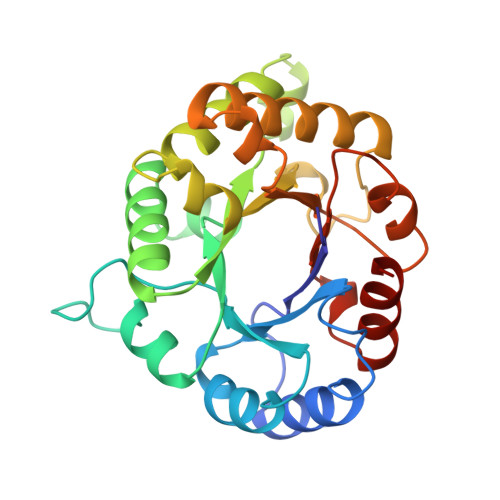Lys13 plays a crucial role in the functional adaptation of the thermophilic triose-phosphate isomerase from Bacillus stearothermophilus to high temperatures.
Alvarez, M., Wouters, J., Maes, D., Mainfroid, V., Rentier-Delrue, F., Wyns, L., Depiereux, E., Martial, J.A.(1999) J Biol Chem 274: 19181-19187
- PubMed: 10383424
- DOI: https://doi.org/10.1074/jbc.274.27.19181
- Primary Citation of Related Structures:
2BTM - PubMed Abstract:
The thermophilic triose-phosphate isomerases (TIMs) of Bacillus stearothermophilus (bTIM) and Thermotoga maritima (tTIM) have been found to possess a His12-Lys13 pair instead of the Asn12-Gly13 pair normally present in mesophilic TIMs. His12 in bTIM was proposed to prevent deamidation at high temperature, while the precise role of Lys13 is unknown. To investigate the role of the His12 and Lys13 pair in the enzyme's thermoadaptation, we reintroduced the "mesophilic residues" Asn and Gly into both thermophilic TIMs. Neither double mutant displayed diminished structural stability, but the bTIM double mutant showed drastically reduced catalytic activity. No similar behavior was observed with the tTIM double mutant, suggesting that the presence of the His12 and Lys13 cannot be systematically correlated to thermoadaptation in TIMs. We determined the crystal structure of the bTIM double mutant complexed with 2-phosphoglycolate to 2.4-A resolution. A molecular dynamics simulation showed that upon substitution of Lys13 to Gly an increase of the flexibility of loop 1 is observed, causing an incorrect orientation of the catalytic Lys10. This suggests that Lys13 in bTIM plays a crucial role in the functional adaptation of this enzyme to high temperature. Analysis of bTIM single mutants supports this assumption.
Organizational Affiliation:
Laboratoire de Biologie Mol¨¦culaire et de G¨¦nie G¨¦n¨¦tique, Universit¨¦ de Li¨¨ge, B6, Sart Tilman, B4000 Li¨¨ge, Belgium.















